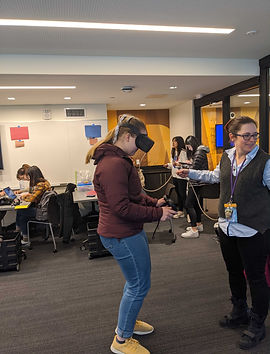
Project ReSET
Creating a virtual world for stressed teens to take a break in their schools
Introduction
Background
I joined Project RESeT in my second year of the HCDE Master's program. The project is led by Dr. Elin Björling and was 1 year in progress by the point I joined. This project is still ongoing and I am presently an active member working as a VR developer and user research assistant.
My Role
VR Developer Lead
Develop VR interactions using Unreal Engine 4, organize collaborative dev sessions, assign tasks to developers, create timelines and deadlines for dev tasks
UX Research Assistant
Participate in strategy meetings, recruit and manage participants, lead participatory design sessions, analyze and synthesize findings
Problem Space
Today’s teens are experiencing more stress than any other previous generation. Repeated stress during adolescence has been shown to decrease cognitive function while increasing rates of anxiety and depression. Eighty-one percent of teens report most of their stress stemming from their school environment and yet, schools are struggling to manage the continued increase of mental health needs of teens.
Solution
Today’s teens are immersed in technology, quick adopters and finding comfort in digital spaces. Virtual-reality (VR) has been shown effective at treating post-traumatic stress disorder and phobias in adults. In addition, the immersive experience of VR has been extremely effective at treating pain in adults, adolescents and children. VR represents an accessible and scalable technology for school-based, or public venue intervention.
Project RESeT is an interdisciplinary project aimed at using the benefits of virtual reality to engage teens in a brief, immersive experience that reduces stress and improves mood. RESeT gives teens the chance to complete destress
User Research
Participatory Design
We used Participatory Design as our primary research methodology for this project. We made it our goal to ensure that our intended user was included during every phase of design, giving feedback on intended features and suggestions to make it best for them.

User Brainstorming
One of the first participatory methods we used was group brainstorming. We invited University of Washington undergraduates to participate in generative ideation sessions. I acted as a facilitator for these sessions, helping guide the conservation and encouraging group discussion. Through these sessions, we gathered a number of common stressors the teens face as well as ideas for activities or environments they would like to see in VR.


I ran a total of 3 sessions, each with 5 undergrad participants. After each session, I would debrief with the project leader, synthesizing the data into actionable tasks.
Usability Sessions
Once we had decided on some activities and features to include, we created simple VR prototypes to run preliminary UX sessions.


Our team held a total of 3 sessions, typically with between 12-15 participants. While we were scheduled to run additional sessions as we continued to develop our prototypes, COVID-19 hit, forcing us to cancel.
Home Study
Because COVID-19 made it impossible to continue testing with users in-person, we had to switch our strategy and figure out a way to gather remote feedback. We decided to re-format our usability sessions into home studies. Luckily, our PI had access to a number of Oculus Quest headsets that she could lend to participants for use at their personal residence.
VR Development
In addition to the work I did as a user researcher, I also worked as a VR developer for the project.
Likert Scale
The first project I worked on was creating a simple prototype for a likert scale in VR. A key design principle of project RESeT is to capture in-the-moment data, so this tool would used to allow users to indicate their stress levels at any given time.

Based on ideas generated from a participatory design session, we decided to try and make the likert scale fit naturally into the world's design. We used the idea of lining up rocks to fit the aesthetic, and I created a prototype to help visualize what it might look like with proper assets.